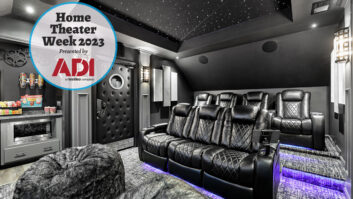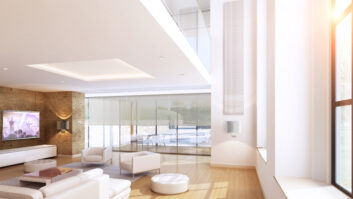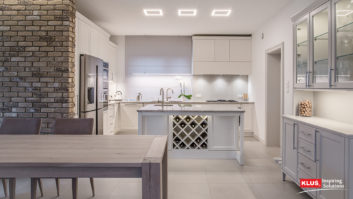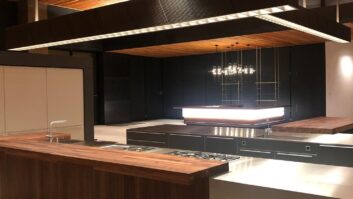This Integration Guide to Lighting and Shades Control was sponsored by Crestron, Leviton, and Qmotion as a supplement to Residential Systems, September 2014.

For Crestron, lighting control and motorized shading solutions are part and parcel of offering control of just about everything within the home. This focus allows the company to zero in on often overlooked areas that can come under the control of a Crestron system, which is why the company’s QMT-163 shade motor for small, shallow windows makes sense. The beauty of curtains has always been their simple, yet multifaceted functionality: block out or filter light while adding aesthetically to a space. The same can be said of the light dimmer, which in its singular elegance has the power to augment a room’s atmosphere. These long-time and still relevant lighting and shading products—the curtain and the dimmer— have been the stakes securing the large tent that is lighting and shade control.
As consumer awareness about the energy-saving and aesthetic benefits of expanding their home’s lighting and shade options continue to grow, integrating and controlling everything from window shades to mood lighting has become the focus of custom integration manufacturers dedicated to making such control a standard component of whole home automation.
“Features that were known on a limited a basis are now widely known and coveted in all products,” noted William Maiman, marketing director for MechoShades’ MechoSystems. “Today, for a large group of users, a window treatment needs to be ‘all things to all people.’ The more functions, options, and capabilities within a product, the greater its desirability. Manufacturers need to be aware of this demand and develop the ability to utilize features of all types even if, in the beginning, it does not seem like a good fit.”
CONNECTED HOME BOOSTERS
Earlier this year, the New York Times’ Claire Cain Miller wondered if the concept of the connected home (defined by Miller as “home appliances and accessories [that] connect to the internet”) will come to fruition in 2014, before swiftly going on to quote statistics that indicate the concept “is still more popular with classic early adopters than with mainstream consumers.”

Lutron, acknowledging the rapid adoption of LEDs and the subsequent desire to control them as easily as incandescents, has issued new products such as the Caseta Wireless and GRAFIK T (pictured), that give homeowners the ability to dim LEDs but to also maximize energy savings. These control products can be connected via Lutron’s Clear Connect wireless technology. Still, in an industry built on creating extremely useful home integration products that eventually find converts among consumers, Maiman’s call to continue developing lighting and shade products that are fully functional and “connected” feels prophetic: a fit will be found.
For Maiman’s company, MechoShades, an example of a device that offers interoperability across manufacturers is the MechoNet Interface, which allows integrators to include products from a variety of manufacturers on the MechoNet proprietary system and giving them a single control platform for all window treatments under a network automation system that is also device independent.
“Therefore, on the output side, motors from different manufacturers can be connected and controlled,” Maiman said. “On the input side, controls and switches that are part of other networks can communicate and be connected. For instance, button presses reliably control devices on MechoNet so that different systems are operating seamlessly. An RS-232/RS-485 port allows for the easy control by other systems or supports configuration tools. Addressing makes for easy integration.”
Savant Systems’ SmartLighting Wi-Fi system uses standard 802.11 Wi-Fi technology for connectivity and programming of the system’s keypads, dimmers, and switches, with each keypad and lighting load becoming part of the home or building IP network, making them as open and available or hidden and secure as your network design allows, as noted by Savant’s co-founder, Jim Carroll. The system, which allows for monitoring of lighting energy usage, can be controlled from one app.

Control4’s adaptive phase dimming technology with automation load detection—found in the company’s Wireless Lighting product family— allows end-users to effectively dim LEDs and control their lighting environment. “The processor and controller for the SmartLighting system are included in all two-gang keypads, at the same price of two single keypads,” Carroll said. “SmartLighting Wi-Fi wall-box dimmers and switches can also be used to accommodate tabletop lighting and/ or retrofit installations. The addition of a Savant Host allows the keypads to perform a near infinite range of control and automation functions for any connected technology.”
Through Savant’s software configuration, users have one- button access to their preferences for lighting, shades, televisions, audio, climate, security, pool/spa, communication systems, and much more.
The “connected home” mind-set was also the driving force behind Hunter Douglas’s Platinum Gateway and Platinum App integration system, which controls the company’s vast array of motorized window coverings from an iOS or Android device.
“The Platinum Gateway and Platinum App integration system addresses the consumer market trend of wanting automated control over certain home functions,” said Paul Kenline, Hunter Douglas’s product and brand manager for automated systems. “The Platinum App is used to configure and control the Platinum Gateway that is connected to the home network. Hunter Douglas motorized window fashions receive commands from the Platinum Gateway and Repeater network wirelessly. Additionally, the Gateway has a timer feature that users can set to move shadings throughout the home at any given time of day.”
To help integrators easily pitch its shade control products to consumers who are familiar with the features and functionality of the most popular home automation systems, Somfy has created myLink, a simple free app that offers features—scheduling, scenes, and remote control—commonly associated with complex control systems.
“The myLink is also very simple to install and makes more efficient use of the time spent with customer,” noted Tracy Christmann, director of marketing for Somfy. “Another great feature of the myLink is that it works with all existing and new RTS installations, which offers a great after sale upgrade for current customers.”
CONTROLLED ECOSYSTEMS
Lutron, acknowledging the rapid adoption of LEDs and the subsequent desire to control them as easily as incandescents, has issued new products such as the Caseta Wireless and GRAFIK T, that give homeowners the ability to dim LEDs but to also maximize energy savings. These control products can be connected via Lutron’s Clear Connect wireless technology.

Environment and natural light management is the driving force behind Draper’s Exterior Window Shades, which is in line with the company’s aim to be as green conscious as possible. When installed, the shade casing is designed to be resistant to weather and insects, which means that replacing on a regular basis will not be required. “Clear Connect wireless technology, found in most of our residential products, reinforces our commitment to innovation and taking care of the customer,” said David Weinstein, vice president of residential sales at Lutron. “Lights turning on when expected is a life safety issue. Our reliable Clear Connect technology ensures that lights and shades work as expected. While it’s helpful to have a home full of connected products, these products need to work every time and perform 100-percent reliably.”
Similarly, Control4’s adaptive phase dimming technology with automation load detection—found in the company’s Wireless Lighting product family—allows end-users to effectively dim LEDs and control their lighting environment.
“The Control4 Wireless Lighting family certainly addresses many of the common technology advancements, including this year’s major transition from incandescents to LEDs,” explained Scott Stephenson, Control4’s senior product manager, lighting and comfort. “With a fresh, sophisticated design, expansive customization options, and wealth of innovative capabilities, the Control4 Wireless Lighting line-up caters to the growing number of residential and commercial projects across our industry.”

MechoShades’ MechoNet Interface allows integrators to include products from a variety of manufacturers on the MechoNet proprietary system and giving them a single control platform for all window treatments under a network automation system that is also device independent. Leviton’s newest lighting control products, including the Vizia RF +, are based on Z-Wave technology, which the company’s director of marketing for security and automation, Greg Rhoades noted ensures “communication to a wide variety of hubs, gateways, and controllers.”
“Leviton’s devices are unique because they feature two-way feedback without polling processes, ensuring that your app or touchscreen always display the proper lighting load percentages and on/off states,” Rhoades added. “We have also just acquired a manufacturer of DIN-rail style lighting controls, a solution already popular overseas but that is beginning to become a demand in the states as well. DIN rail reduces wiring requirements and Leviton’s Omni-Bus line allows for third party switch interfaces to match aesthetic demands internationally.”
This month, Vantage Controls, which last year introduced a smartphone app as a companion to its Equinox family of LCD touchscreen user interfaces, will release Equinox 41, a multifunction rich media LCD touchscreen that fits in a single gang box, offering what director of marketing, Reid Cram referred to as “on-the-wall and on-the-go control.”
AESTHETIC AND ENVIRONMENTAL CONTROL
For home automation giant Crestron, lighting control and motorized shading solutions are part and parcel of offering control of just about everything within the home. This focus allows the company to zero in on often overlooked areas that can come under the control of a Crestron system, which is why the company’s QMT-163 shade motor for small, shallow windows makes sense.

QMotion’s Qadvanced Roller Shades are batteryoperated (also available in low voltage hard-wired) and are now available in 15.5-inch wide dimensions to extra large sizes that can be linked together with QMotion’s Qlink coupler system. “Our new CSM-QMTDC-163-1 digital motor fits inside a 1.63-inch shade motor tube to accommodate smaller shade mounting brackets,” said Phil Scheetz, Crestron’s shade and lighting marketing manager. “Available with Cresnet wired or infiNET EX wireless communications, the CSM-QMT-163-1 can integrate seamlessly into a Crestron control system to be operated from keypads, wireless remotes, and touchscreens.”
The fully integrated shading solution eliminates the need for bulky add-on interface modules, allowing for a clean, streamlined installation. The Crestron shades inconspicuously fit into these smaller windows providing a clean, minimalist look.
Environment and natural light management is the driving force behind Draper’s Exterior Window Shades, which is in line with the company’s aim to be as green conscious as possible. The company uses lean manufacturing processes to reduce waste, and finds and works with fabrics and materials that have the least environmental impact, noted Bob Hadsell, Draper’s home theater sales manager, who also explained that when installed, the shade casing is designed to be resistant to weather and insects, which means that replacing on a regular basis will not be required.
“As our homeowners and business owners become more green conscious, it is important for the industry to look for solutions that will be environmentally friendly, both in manufacturing and in intended use,” Hadsell said. “Manufacturers need to be producing with materials and processes that leave a smaller environmental footprint, while maintaining the quality that the U.S. consumer expects. These products must then be able to operate more efficiently, provide cost savings or make use of the least amount of utilities as possible.”
Additionally, Hadsell noted that it’s important to point out that the same solution may not work for everyone. “So, we are not looking at only standard items; we also supply unique custom solutions which meet the needs of the building,” he stated.
QMotion’s Qadvanced Roller Shades accentuates the company’s drive to produce energy and light management solutions that are easy to use, install, and retrofit while providing quiet operation and sleek design. Offering a breadth of unique fabrics that filter light and accent décor, Qadvanced Roller Shades are battery-operated (also available in low voltage hard-wired) and are now available in 15.5-inch wide dimensions to extra large sizes that can be linked together with QMotion’s Qlink coupler system.
“The sleek design says it all—the batteries and motor are ‘hidden’ in the shade tube, so no wires or external battery packs are visible, and it makes it easier for retrofit situations, as you don’t need to break into a wall for wiring or hire an electrician to install,” said Cassie Metzger, QMotion’s senior brand development manager. “QMotion shades are a snap to install and even easier to operate via remote, smartphone, tablet or even by hand, with our patented manual override feature. These shades can be integrated with all of the leading home automation systems.”
SHADES OF THE FUTURE
The Connected Home as envisioned as an internet-centric hub of control and automation may be a ways off yet, but big changes are often implemented in small stages. The fact that—as wireless technology continues to reveal new and exciting ways to connect us with the things we use every day and further still, connect those things to each other—the relatively niche channel of lighting and shading control can offer a map of future elegance.
“As more and more systems become part of the ‘connected home’, there will be a greater need for seemingly dissimilar products to communicate with each other,” noted Kenline of Hunter Douglas. For example, the thermostat will need to communicate with the shades to lower them when the A/C is activated. Or maybe the other way around… A lighting system can be integrated, as well, and a whole myriad of event-driven actions can take place without any input from the homeowner. Shade control of today is a far cry from the manual lifting cords our grandparents used to raise and lower their window coverings, and the future is only going to get brighter…well, smarter, at least.”
Llanor Alleyne is a contributing editor to Residential Systems.







